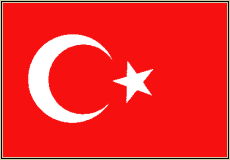
|
 |


Ottoman Empire

 |




The most used flag by the Ottoman Empire. An earlier version is supposed to have had a 7 pointed star.



Click to open interactive map to show the borders through the empire's 622 years.

|
Empire based around the Turkish sultan, lasting 1300-1922, 622 years, covering at its peak (1683-1699) an area including today's Hungary, Yugoslavia, Croatia, Bosnia, Albania, Macedonia, Greece, Romania, Moldova, Bulgaria, southern Ukraine, Turkey, Georgia, Armenia Iraq, Kuwait, Cyprus, Syria, Lebanon, Israel, Palestine, Jordan, eastern and western Saudi Arabia, Oman, Bahrain, eastern Yemen, Egypt, northern Libya, Tunisia, and northern Algeria.
 The Ottoman Empire was not a Turkish empire as such, since Turks did not profit more from the benefits of the state than the peoples in non-Turkish territories. And even though the first sultans were Turkish, they generally married non-Turkish women, so the race of later sultans was not Turkish either. The Ottoman Empire was not a Turkish empire as such, since Turks did not profit more from the benefits of the state than the peoples in non-Turkish territories. And even though the first sultans were Turkish, they generally married non-Turkish women, so the race of later sultans was not Turkish either.
 The empire was through most of its period not a state in the modern sense of the word, but more of a military administration. The empire was through most of its period not a state in the modern sense of the word, but more of a military administration.
 While the Ottoman Empire at its death bed had few friends, it still had offered its inhabitants many benefits through most of its existence. For Muslims it was considered as a defence against the non-Muslim world. For non-Muslims it offered a better life and more security than Christian states up until the 18th century. For most of its inhabitants it had offered career possibilities. And it offered peace and relative harmony to all its inhabitants despite cultural and ethnic differences. While the Ottoman Empire at its death bed had few friends, it still had offered its inhabitants many benefits through most of its existence. For Muslims it was considered as a defence against the non-Muslim world. For non-Muslims it offered a better life and more security than Christian states up until the 18th century. For most of its inhabitants it had offered career possibilities. And it offered peace and relative harmony to all its inhabitants despite cultural and ethnic differences.
|
|

